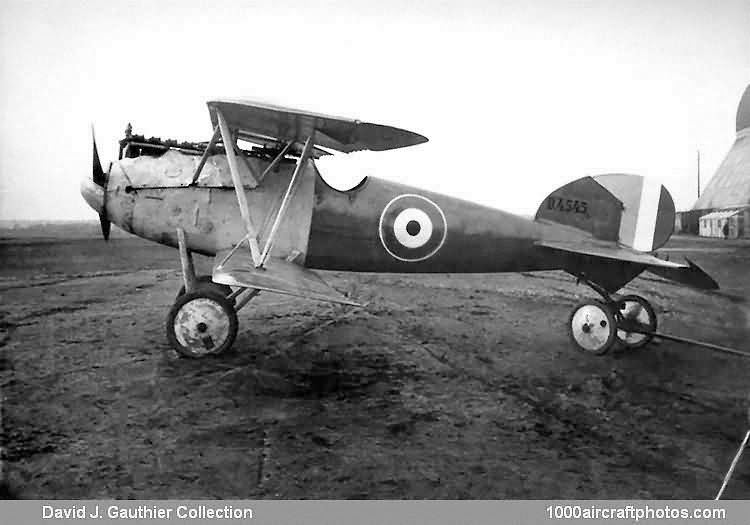In the autumn of 1917 the supply of D.Vs was supplemented, and eventually replaced, by the D.Va, which (as will be explained) differed very little from its predecessor. Both variants were fitted with either an 180 hp or a 200 hp Mercedes D.III six-cylinder liquid-cooled in-line engine. (Basically an 160 hp Mercedes with high compression and oversize cylinders fitted.) Both variants also used the same armament, two fixed Spandau machine guns synchronized to fire through the airscrew.
In an endeavor to obtain an increased performance from a more-or-less standardized airframe, a major redesign of the fuselage was undertaken. This dispensed with the flat sides of the D.I/D.III series and introduced a more truly elliptical section, endowing the fuselage with a more refined and pleasing appearance. An additional longeron was necessary along the center line on each side of the fuselage, which was wider than on the D.III. A spinner of increased diameter was also fitted. A headrest was incorporated in the design of the new fuselage, but as it tended to restrict rearward vision, it was often removed on active service. The prototype D.V had a D.III type rudder, but thereafter the more familiar rounded rudder was fitted. The tail plane and elevator were interchangeable with those of the D.III, but the under-fin was modified, its trailing edge being raked back at some 45° instead of vertical as before.
The ailerons of the D.V also departed from previous practice. The cables now ran through the top wing (and not the bottom as before), where they angled back through 90° and were locked on to pulleys to the aileron leading edge. Small shrouds covered the cables where they emerged through the wing surface. The wing itself was otherwise identical in shape, dimensions and construction with that of the D.III, retaining the Teeves and Braun radiator in the starboard side of the center section. The D.Va revived the D.III type aileron modus operandi, with the cables running through the lower wing, the only difference being a slightly shortened operating crank. The wings were, in fact, interchangeable with those of the D.III. As in the D.V, D.Va's were seen both with and without headrests, and the only certain means of distinguishing one from the other was by the location of the aileron control wires.
As compared with the D.III type, the gap of the D.V and D.Va types was reduced by some 4 in (10 cm); the wing structures were otherwise the same except in the aileron operation. The unfortunate tendency to break up in a prolonged dive remained, and at the time the reason for this was not fully understood. Although static load tests confirmed that the structural strength of the lower wings was more than sufficient, it was found at a later date that the single spar was positioned too far aft. This caused vibrations which, in a long dive, increased proportionately, eventually resulting in wing failure. A partial cure, or at least an increased safety margin, was achieved by fitting a short auxiliary strut from the leading edge to the V-interplane strut. Even then, pilots were advised not to over-dive their Albatroses. The effect upon morale of such a restriction on a vital combat maneuver may well be imagined.
The Albatros D.V first entered service in May 1917, and from the middle of 1917, as the number of Jagdstaffeln (fighter squadrons, often abbreviated to Jastas) increased, so they were equipped with Albatros types except for the units that also had Pfalz D.III and Fokker Dr.Is on their strength. Of all the Jastas that were eventually raised in readiness for the March 1918 offensive, it may be safely said that all, at one time or another, flew either Albatros D.III, D.V or D.Va, some having a "mixed bag" of all types.
Vast numbers were operated and, as if to counteract their structural shortcomings, many were adorned with bizarre insignia and garish color schemes to bolster their pilot's morale. Lt. von Hippel of Jasta 5, who once miraculously crash-landed his D.Va safely after the lower wing came away at 16,000 ft (4,877 m), had a fire-breathing black dragon emblazoned along the fuselage. Lt. Hermann Göring (later to become the infamous head of Hitler's Luftwaffe) led his Jasta 27 in a black fuselaged D.V with nose and tail portions painted white. Richthofen was shot down in the D.V with s/n D.1177/17 on July 6, 1917 and later flew another, s/n D.4693/17, during the Battle of Cambrai. The leader of Jasta 21, van Schleich, was known as the "Black Knight" because of his all-black Albatros D.V, which he flew on the French Front.
The Albatroses of Jasta 21 shot down 41 French aircraft during September 1917. And so the ubiquitous Albatros fighters continued to fly on all fronts. Manufacture was finally discontinued in 1918 in favor of the Fokker D.VII, but they remained in action in considerable numbers right up to the end of hostilities. In September 1918 some 327 D.V and D.Va's were in front-line service – the peak figure was in May 1918, when 131 D.Vs and 928 D.Va's were with the various Jastas in all theatres of operations.
One Albatros D.Va, s/n D.7117/17, experimentally fitted with an 185 hp BMW D.IIIa, achieved a ceiling of 34,449 ft (10,500 m) on February 6, 1918, although this was with an uncorrected barograph. The pictured D.Va, s/n D.4545/17, flown by Max Wackwitz of Jasta 24, was forced down by anti-aircraft fire in December 1917. The aircraft was then given an RFC capture number, G97, while also RFC roundels and fin flash where applied."
